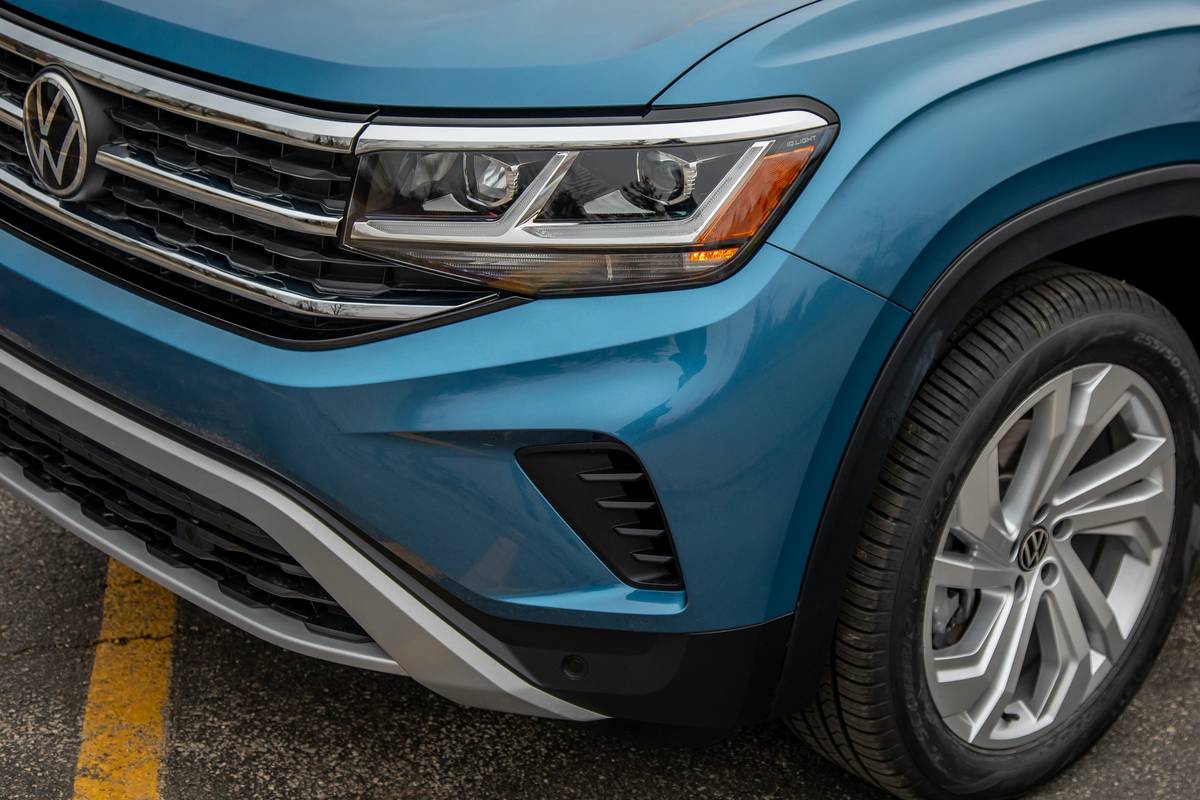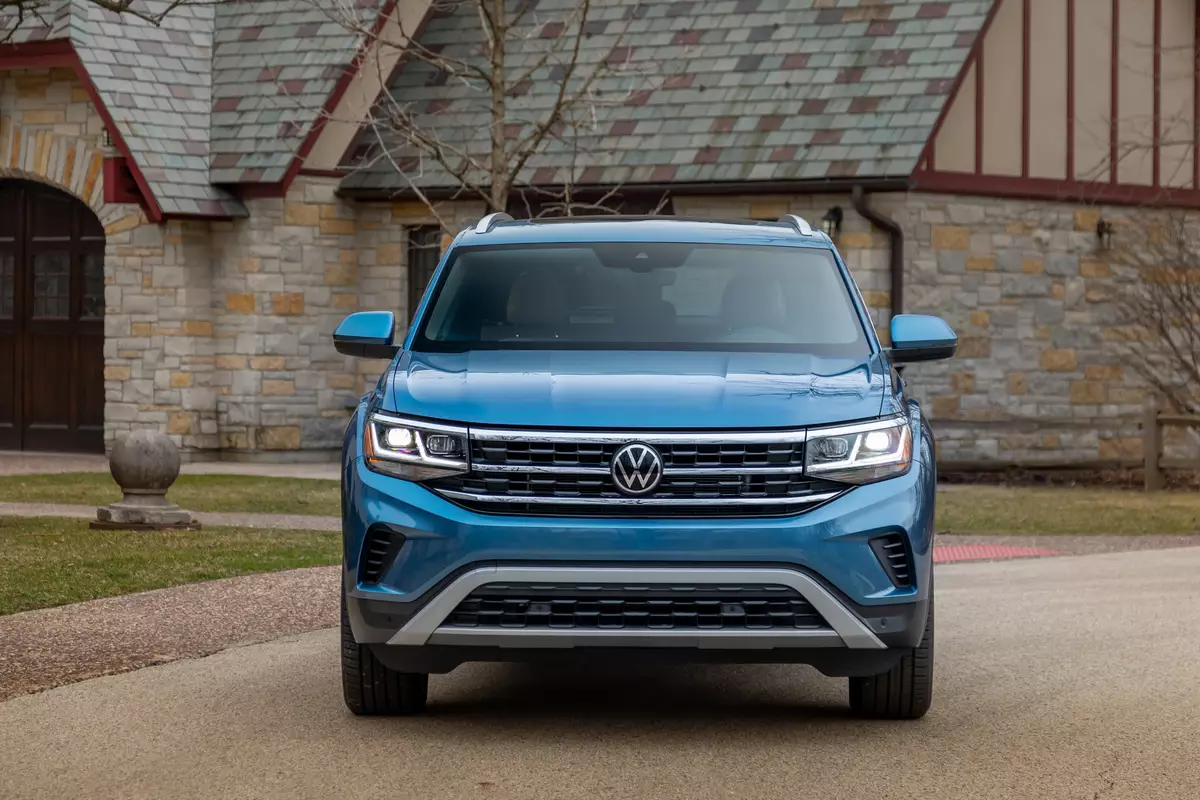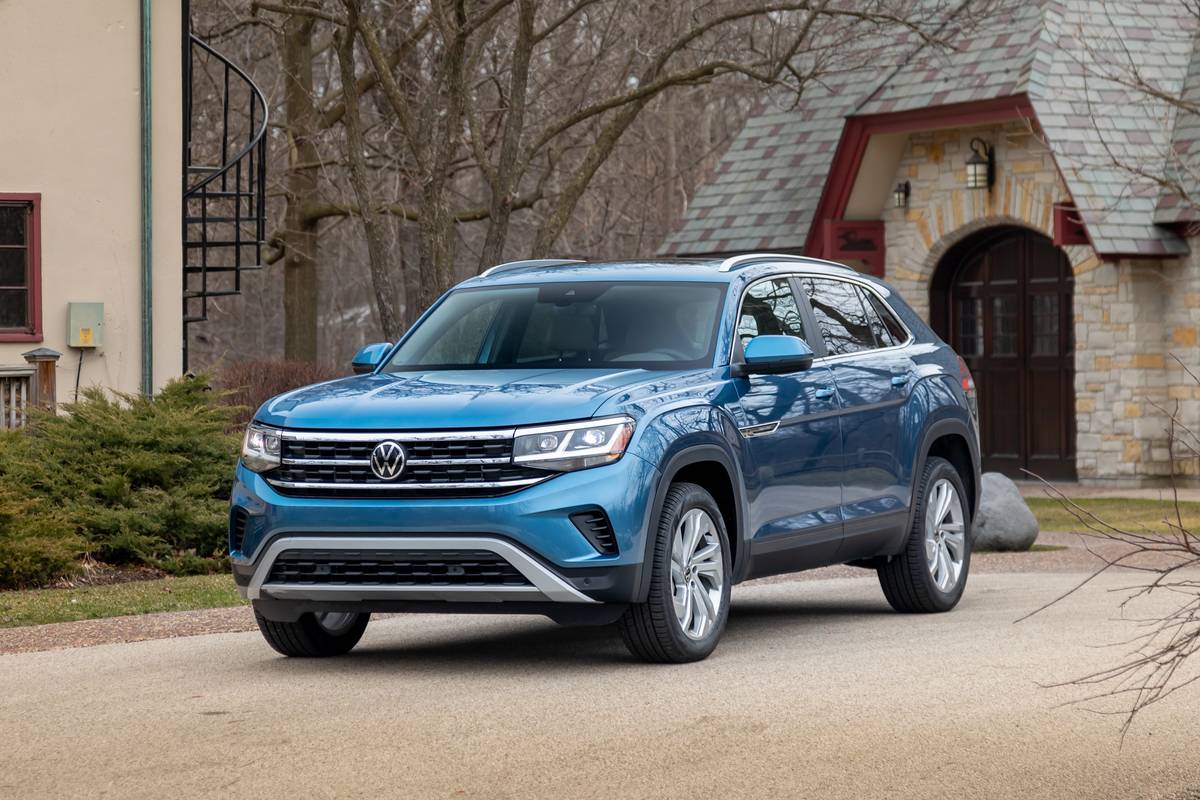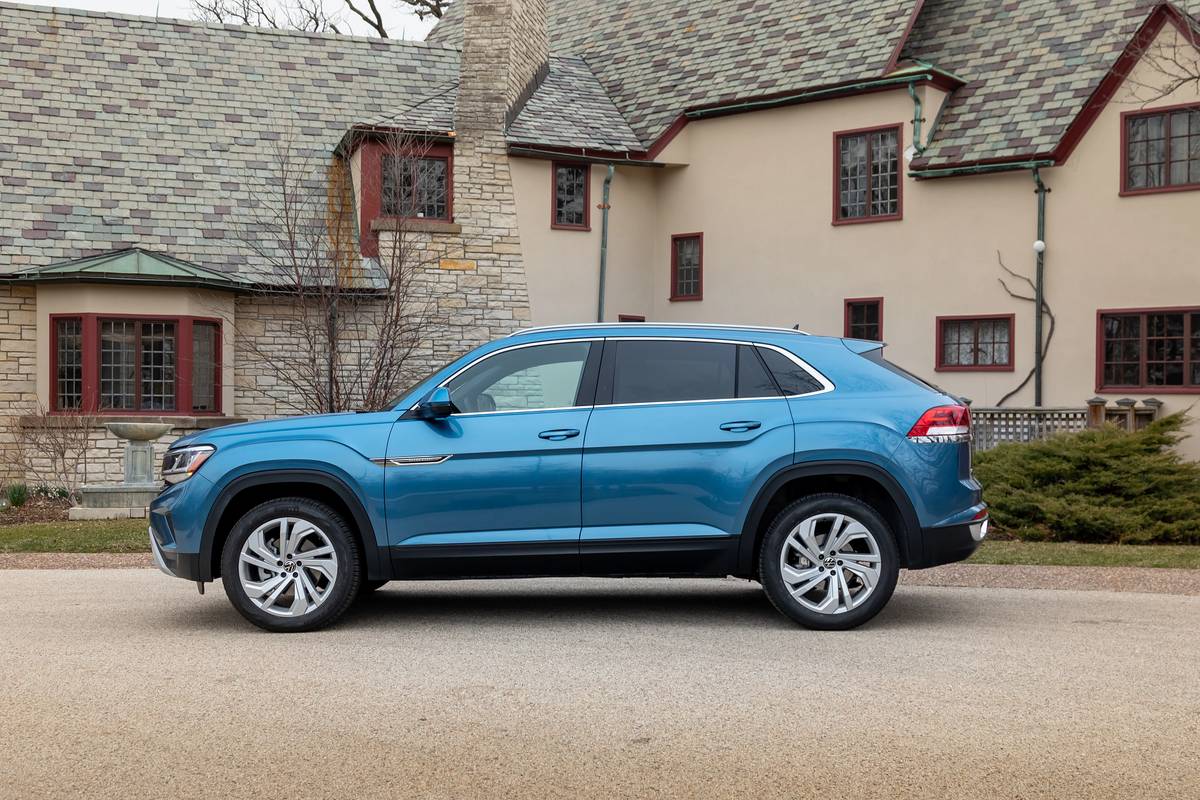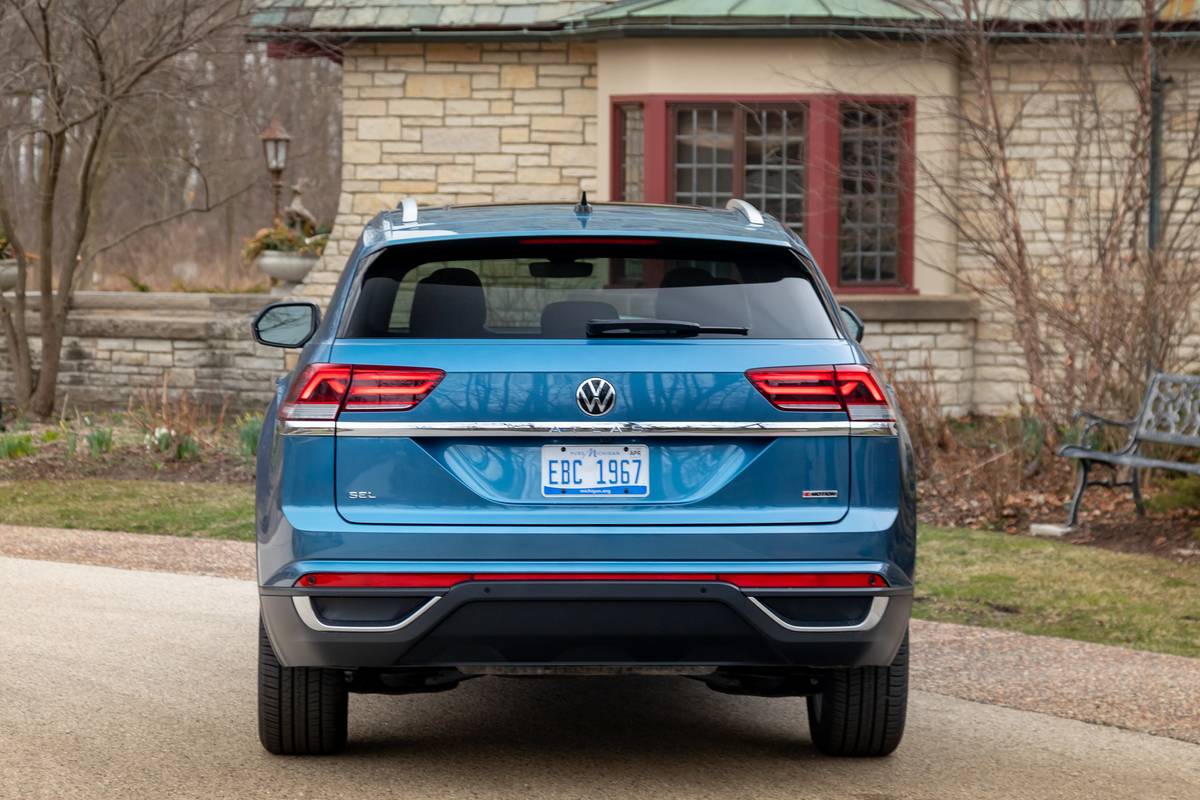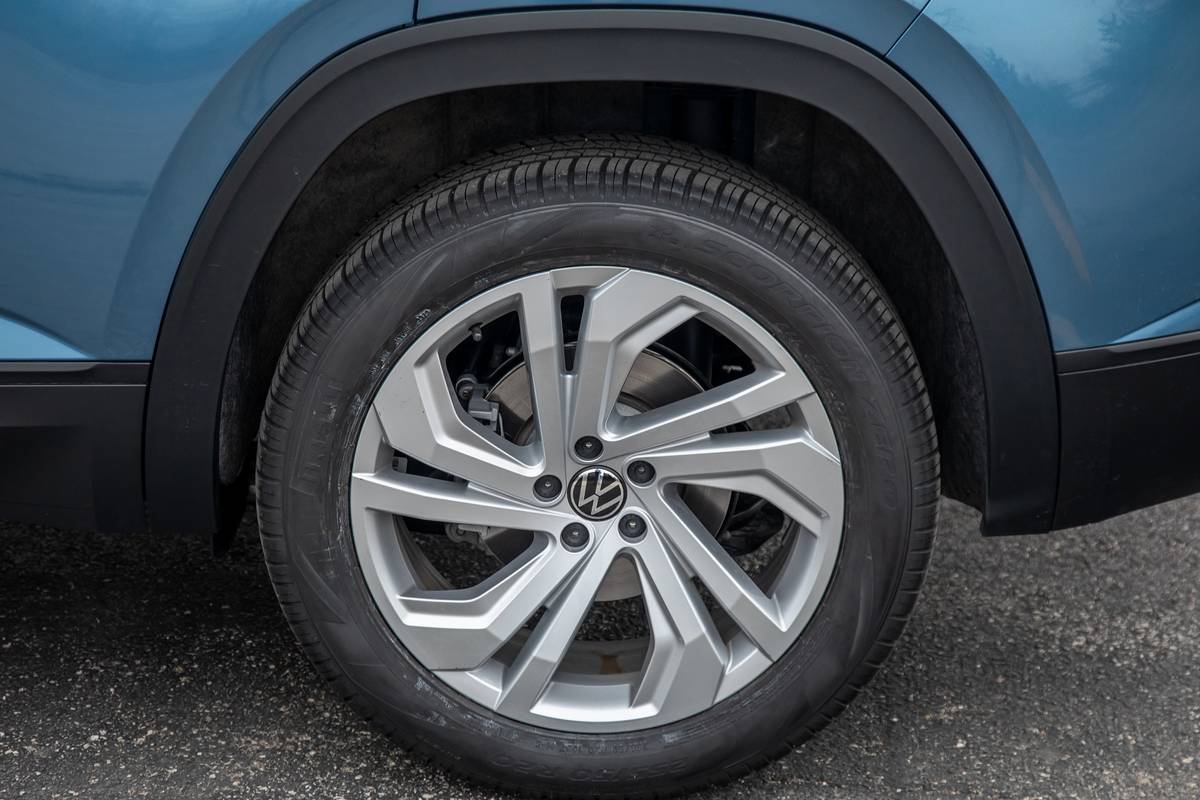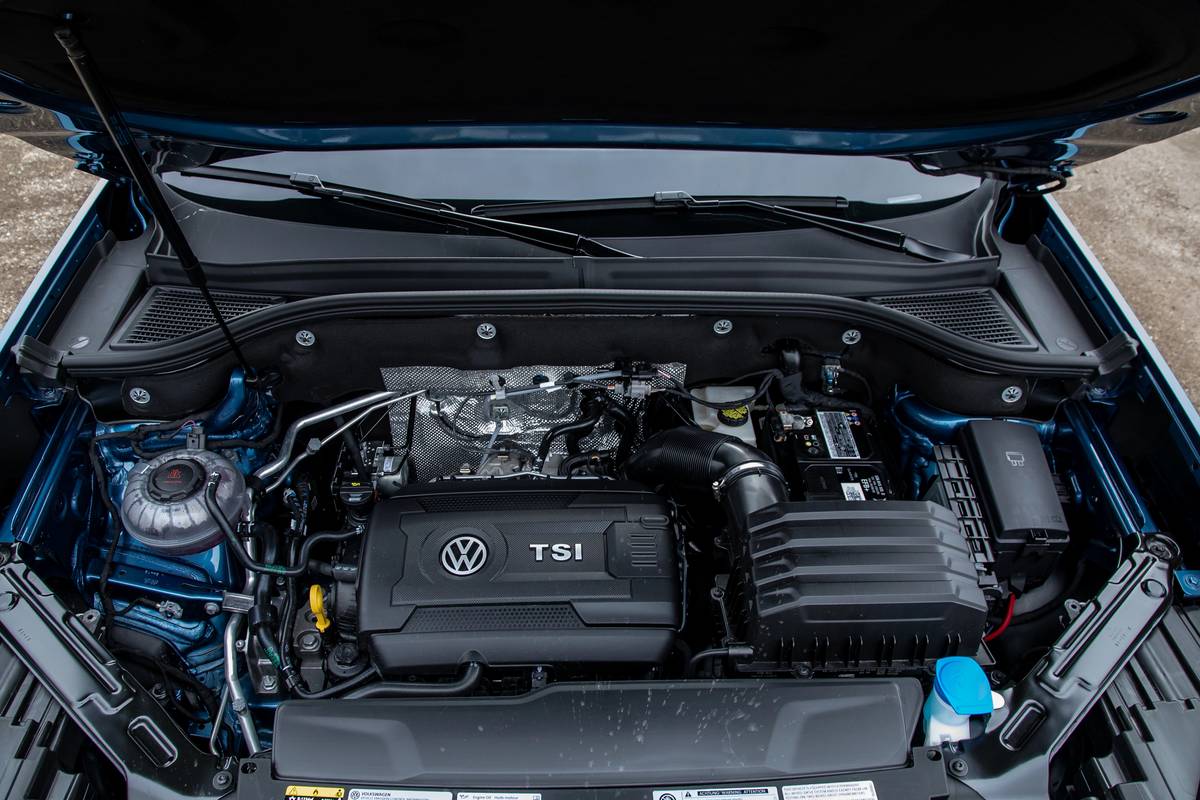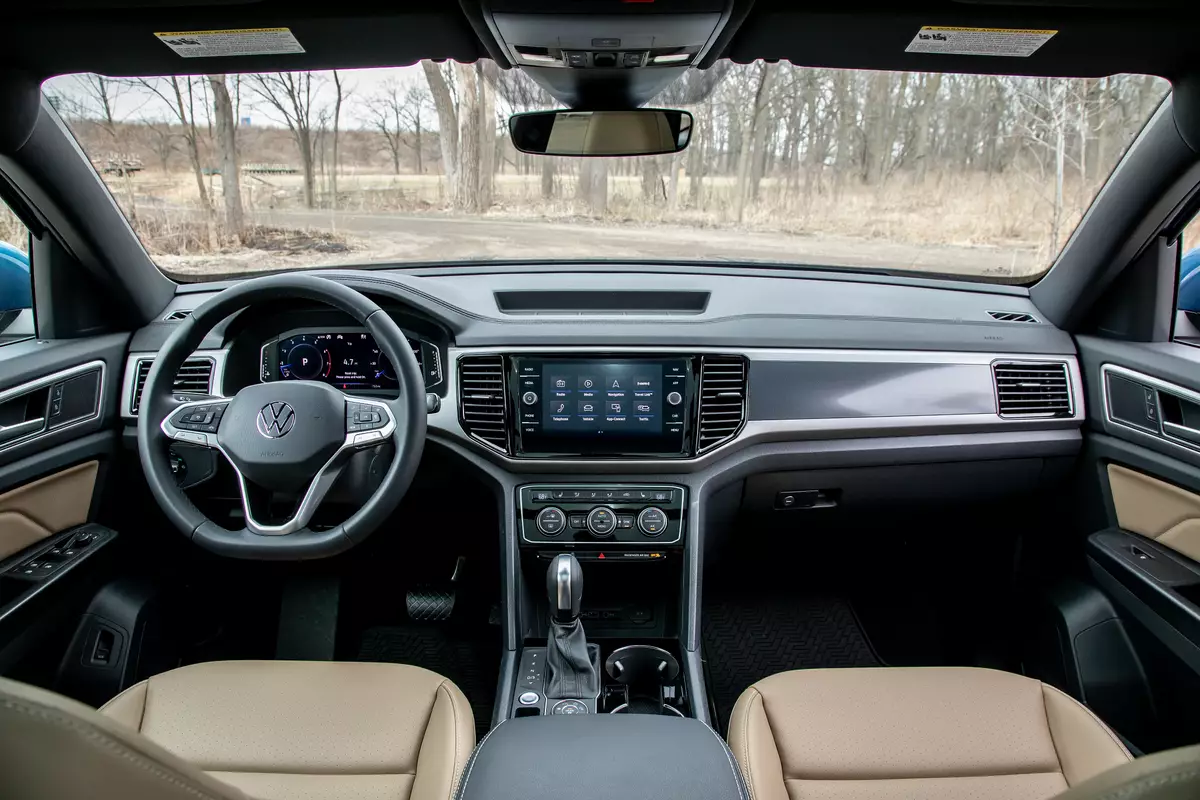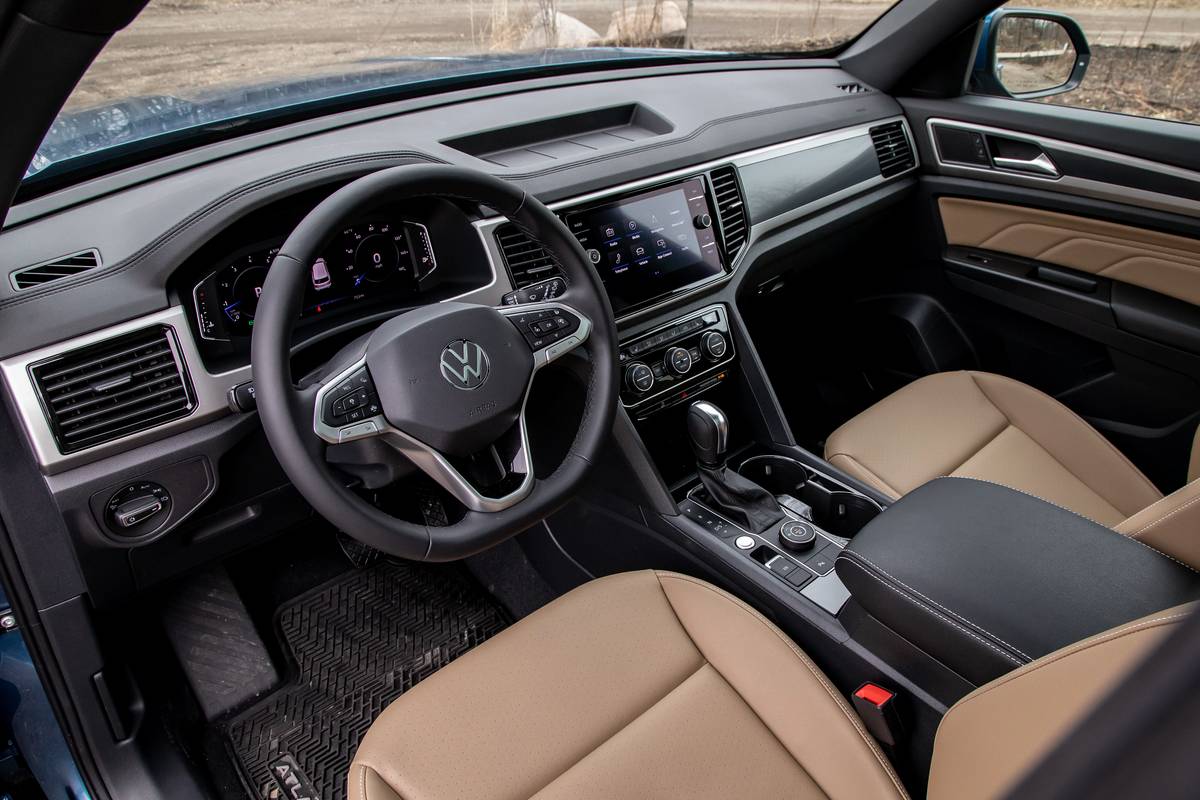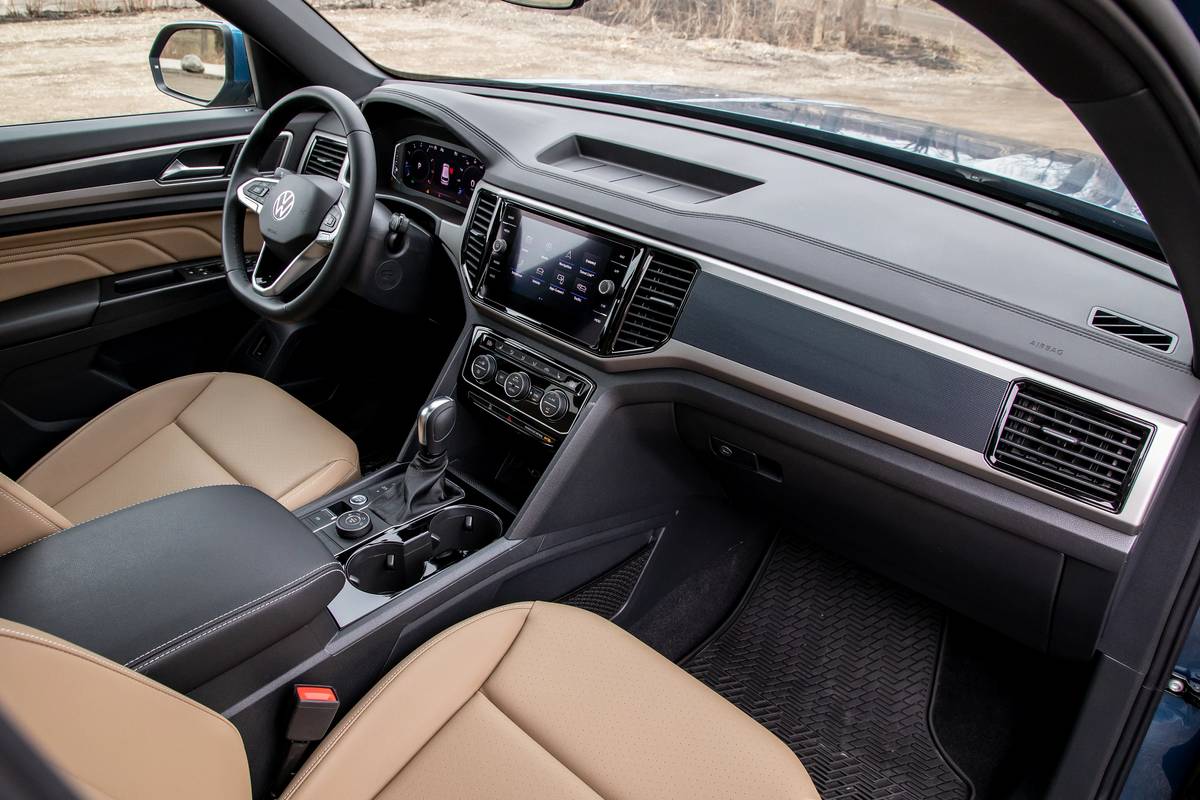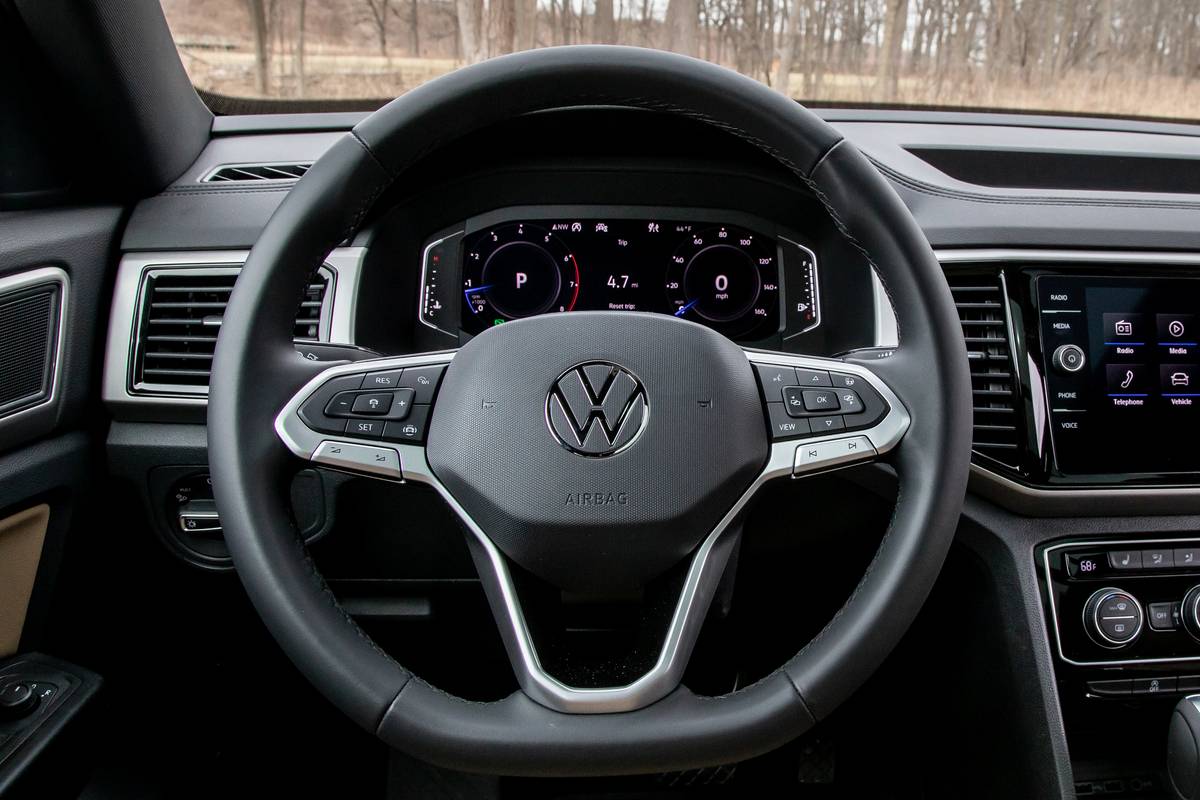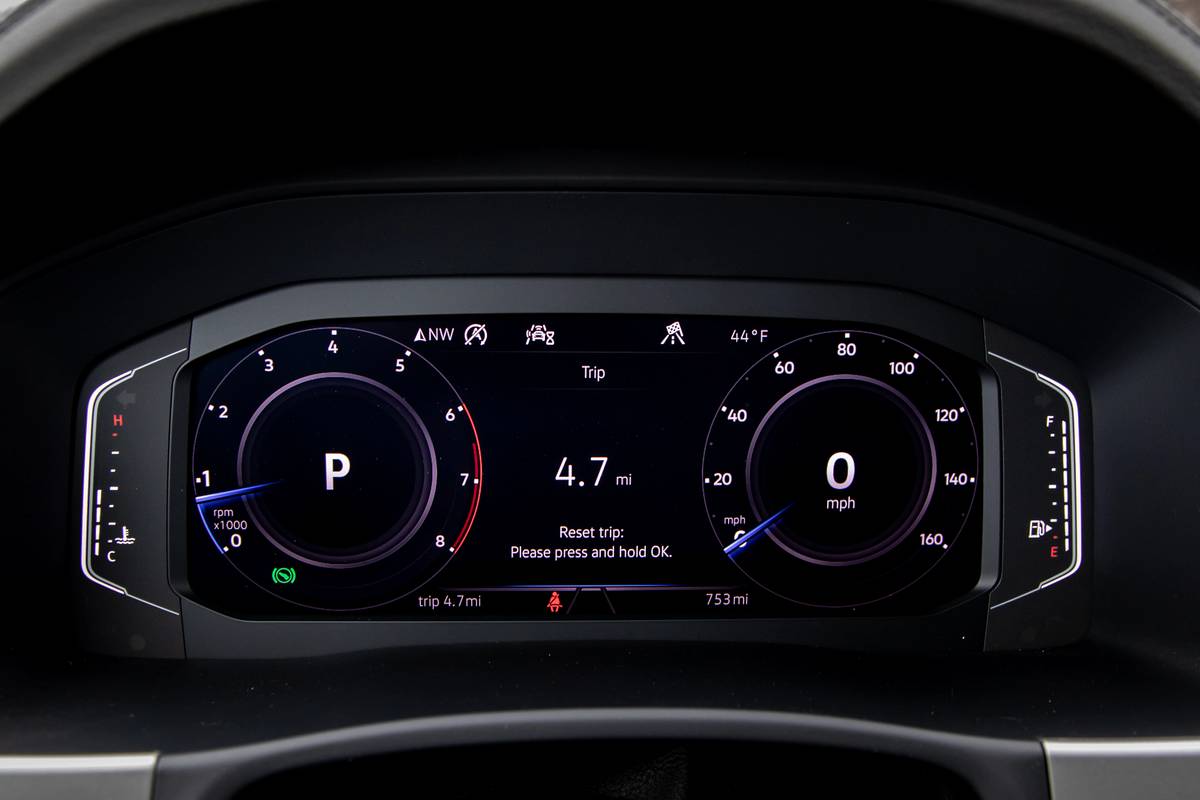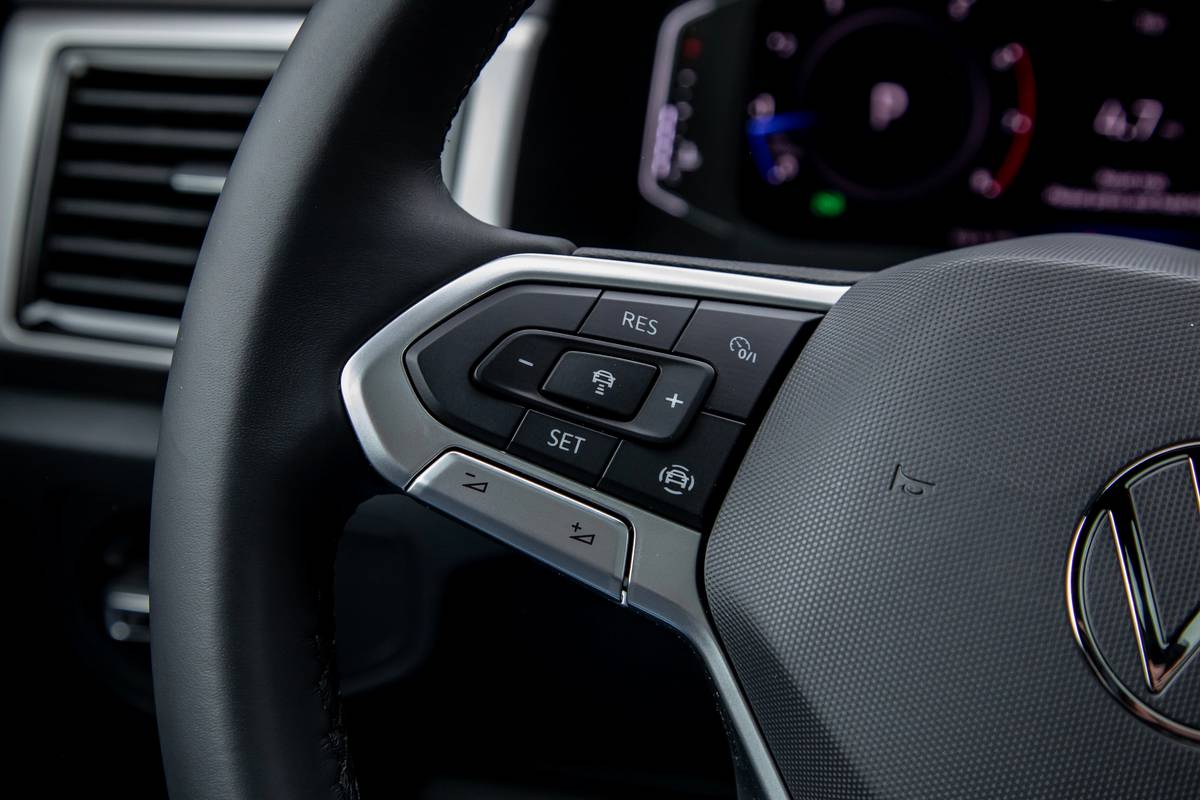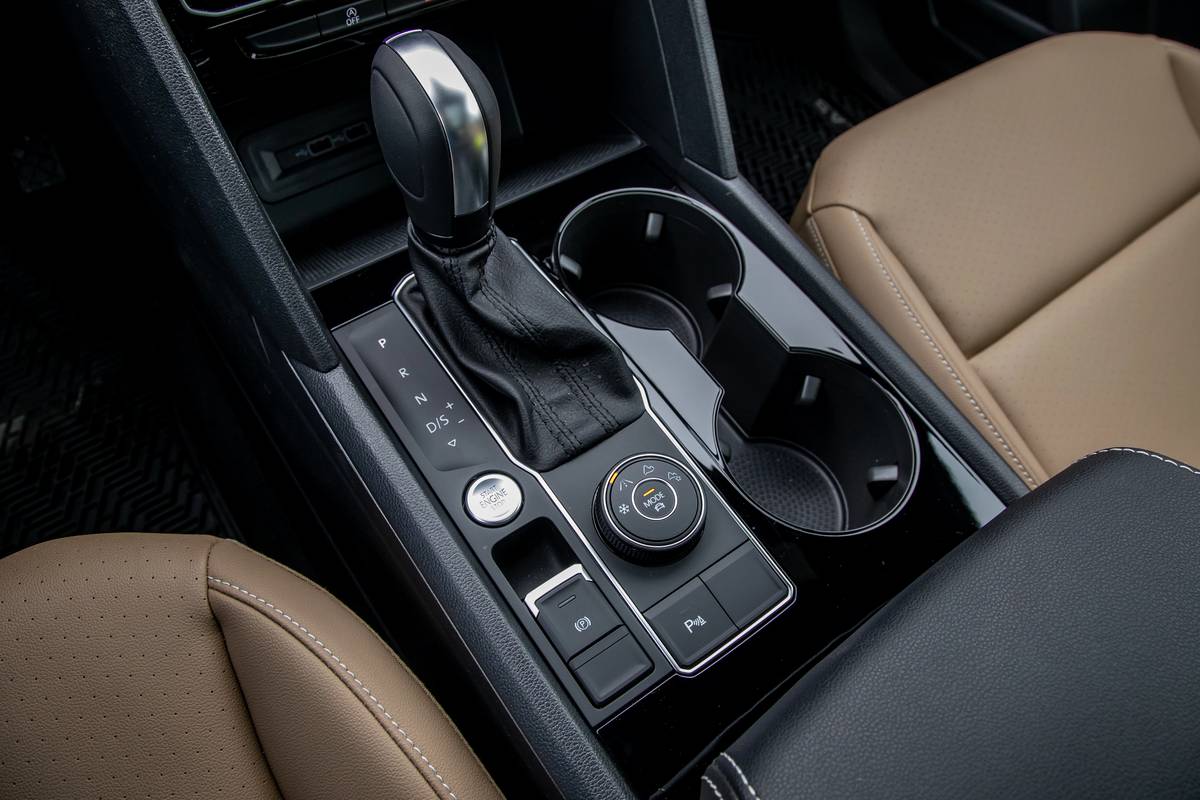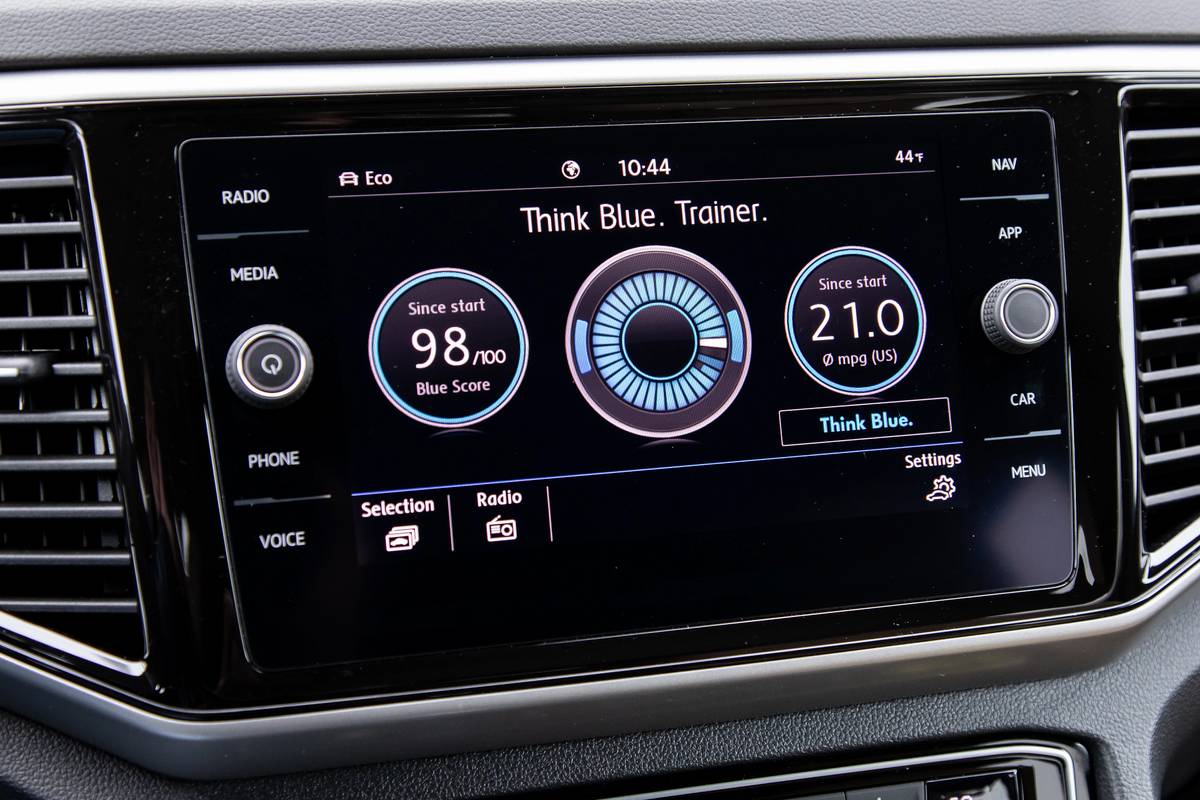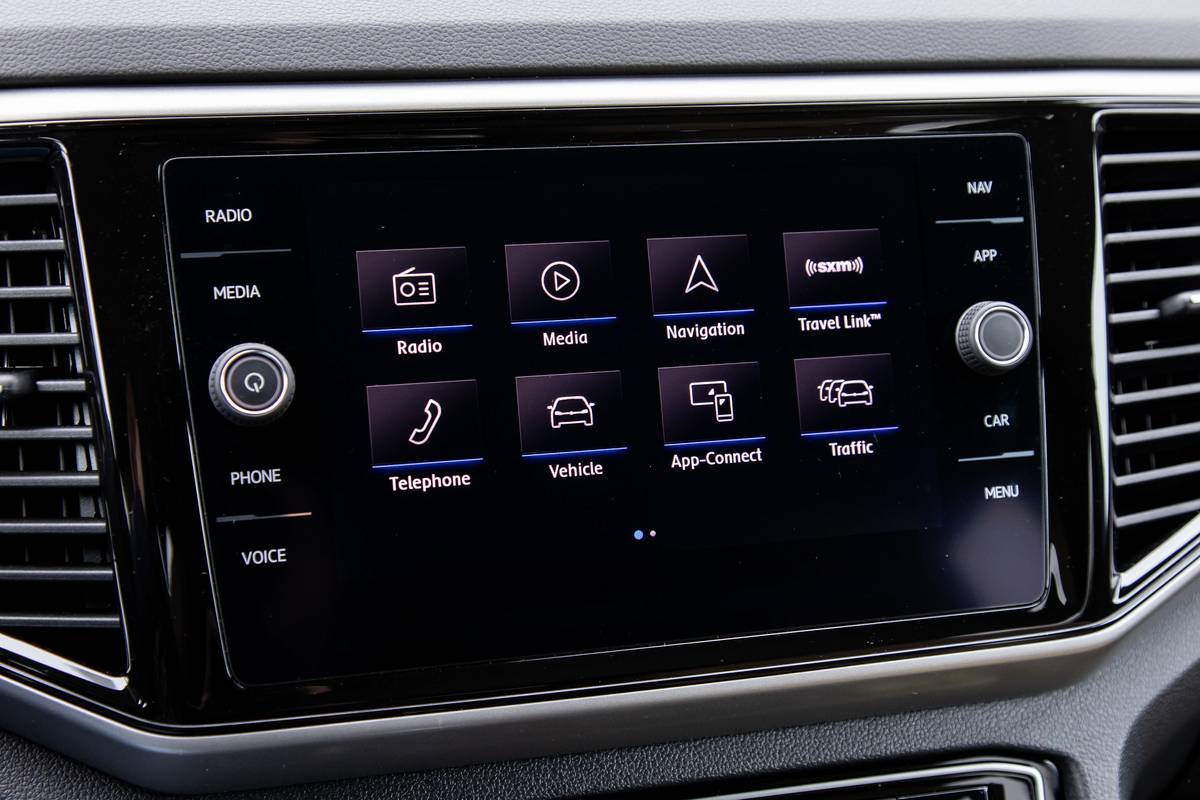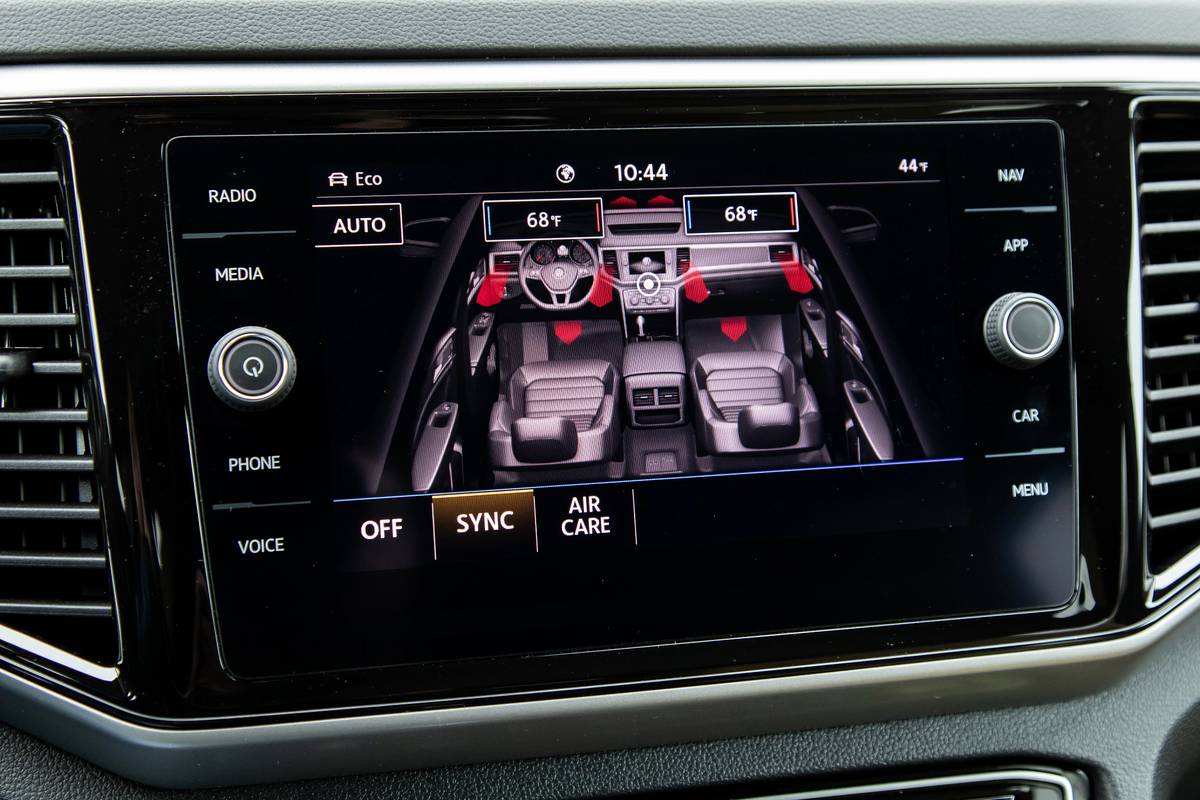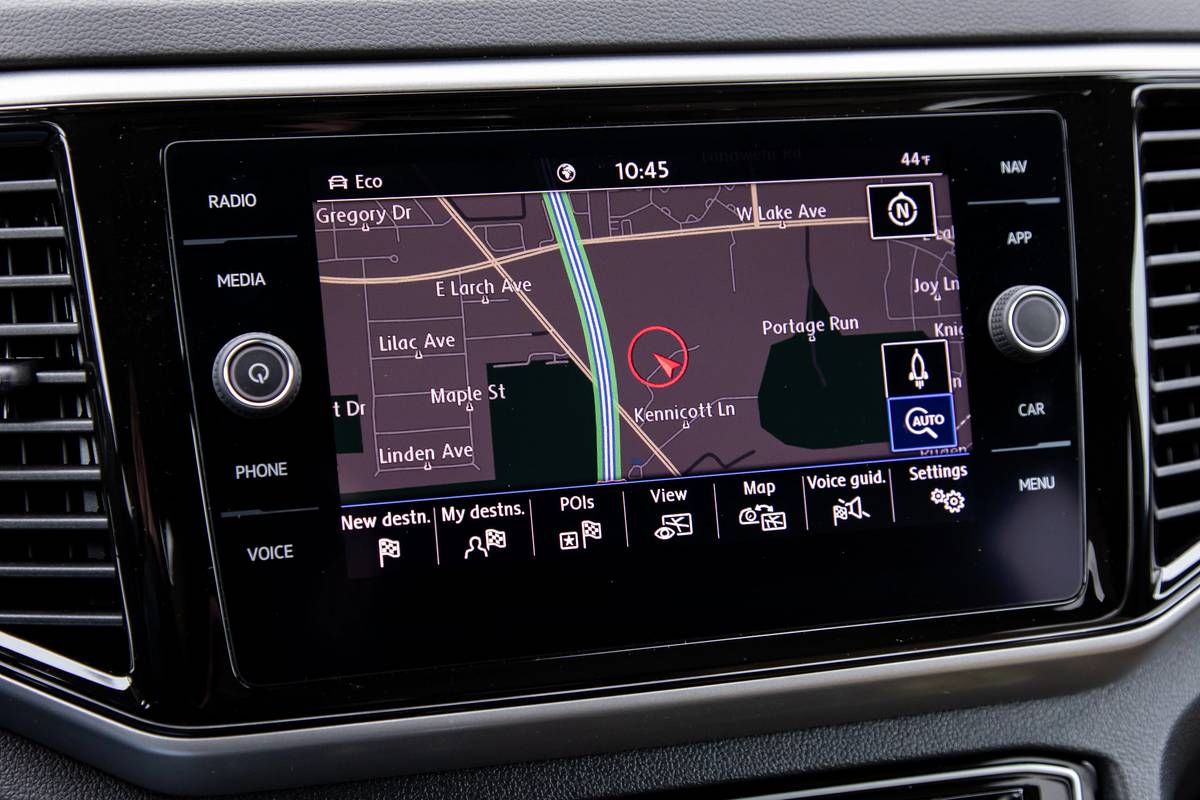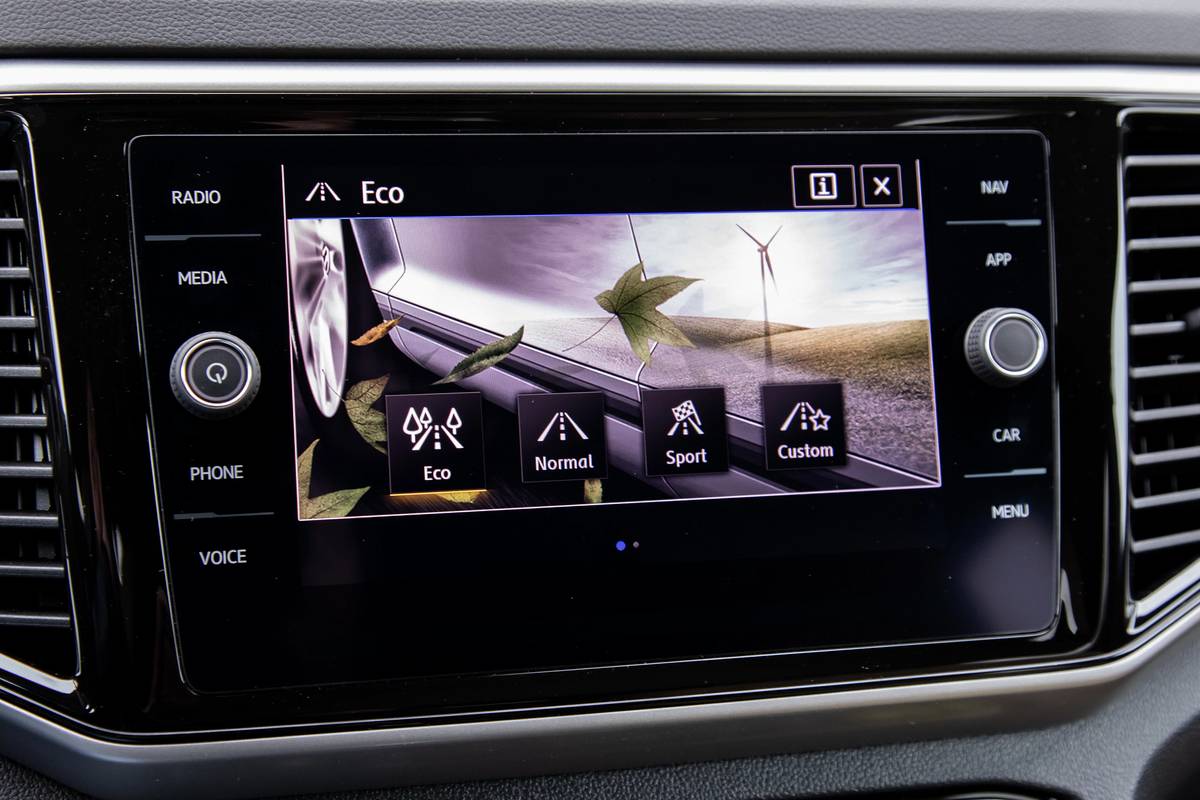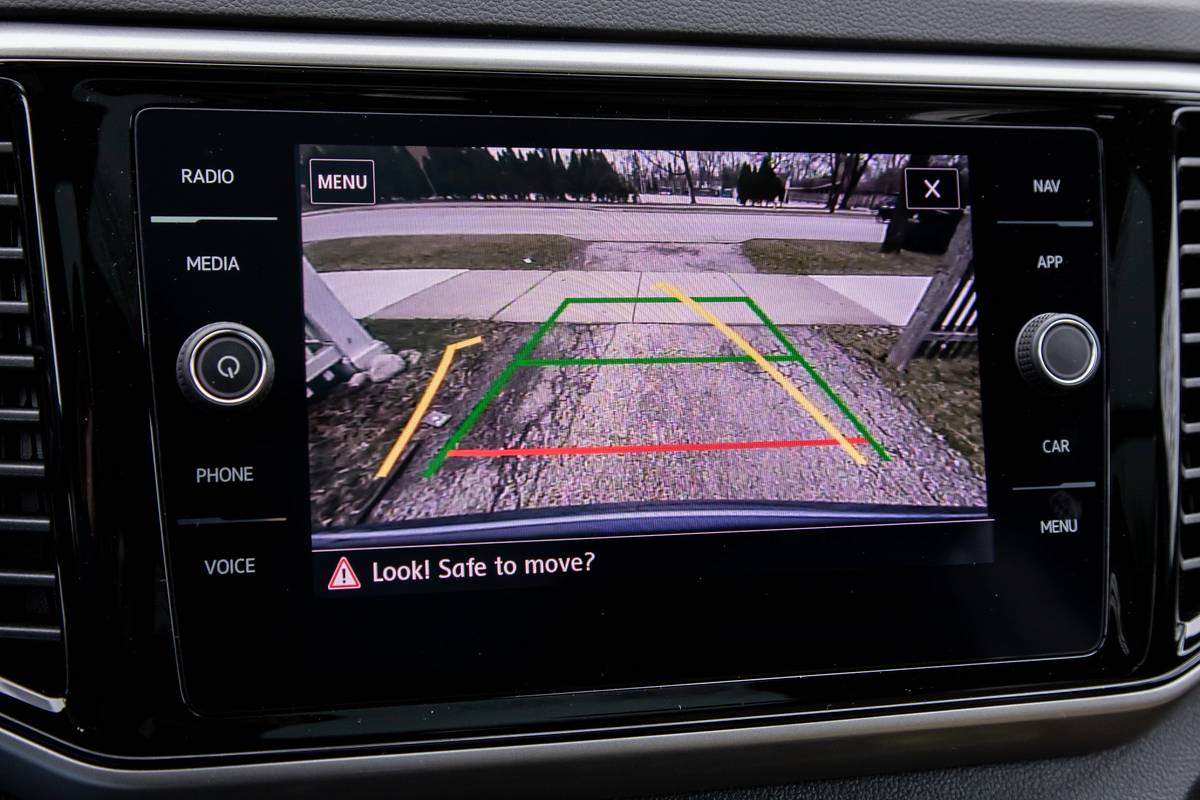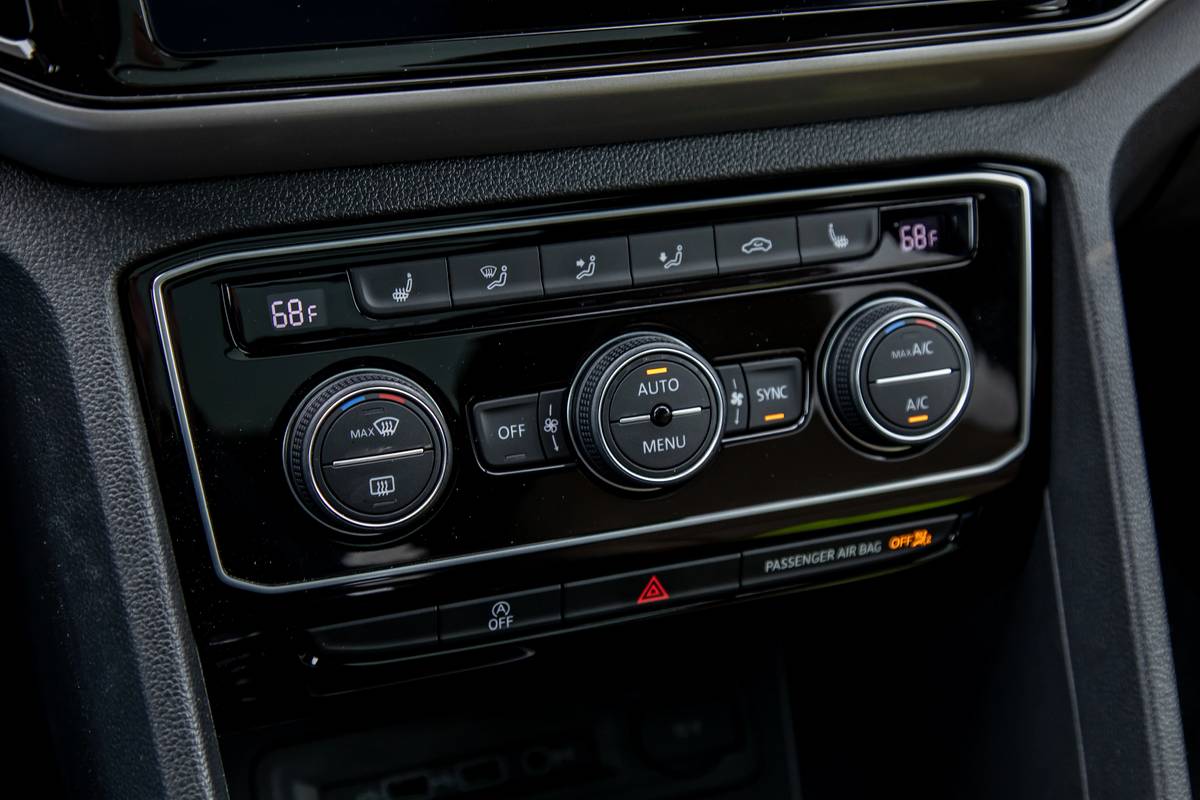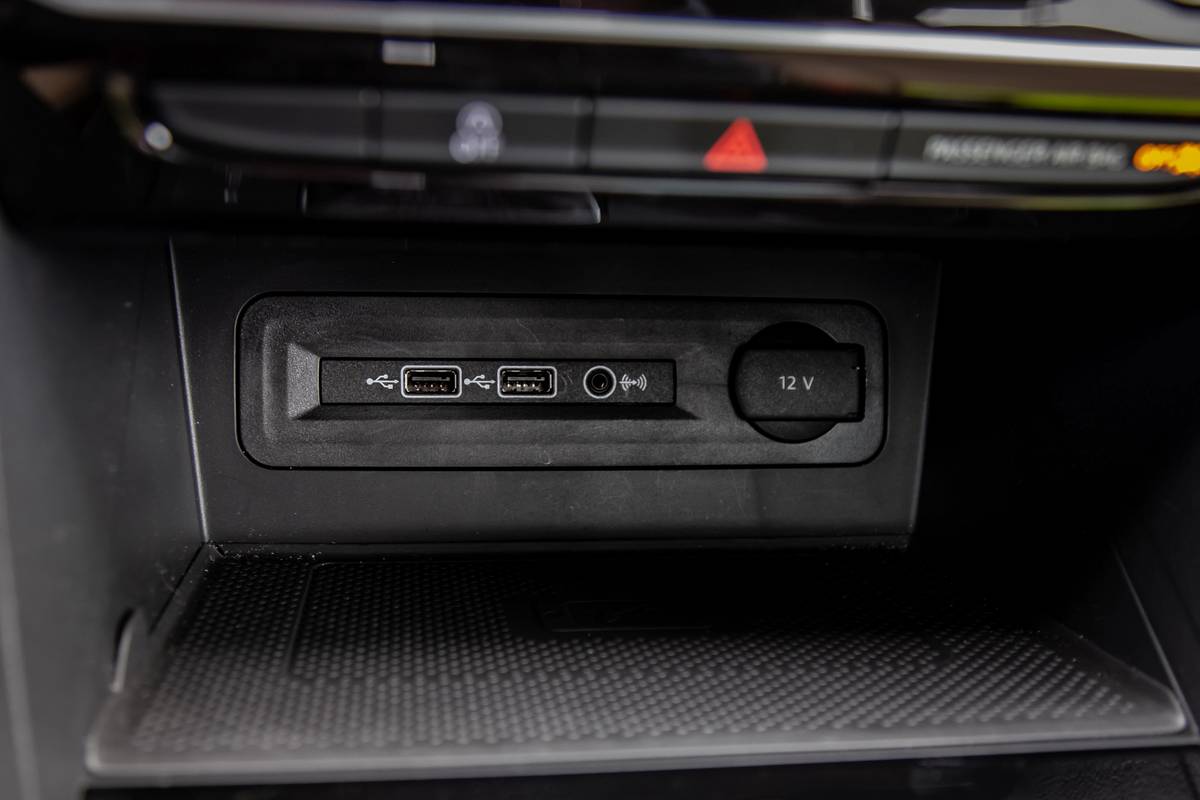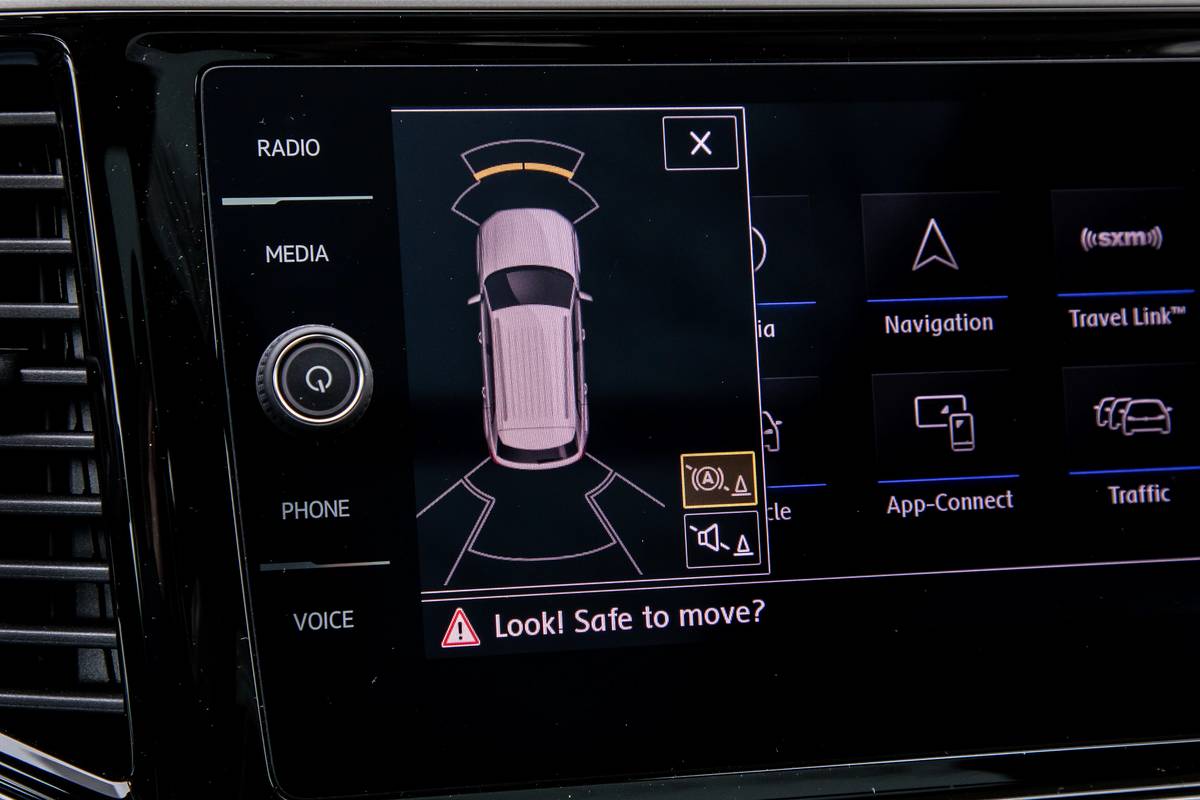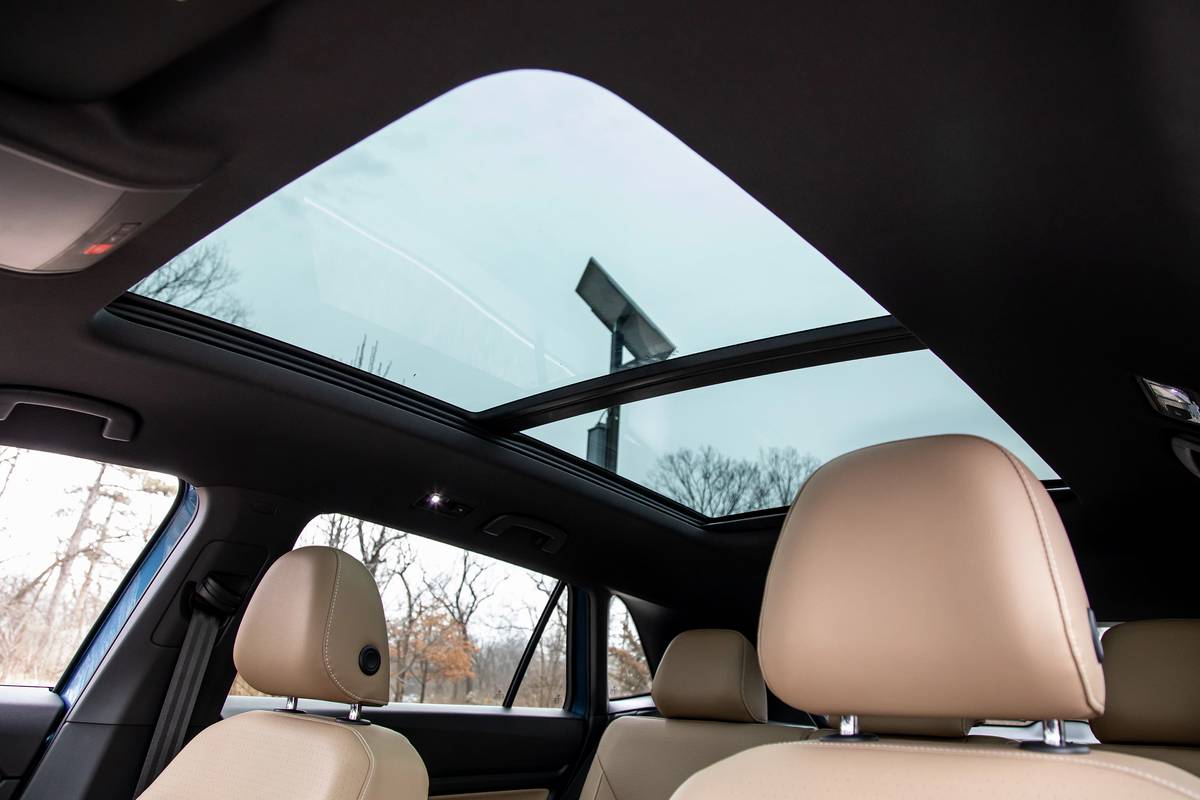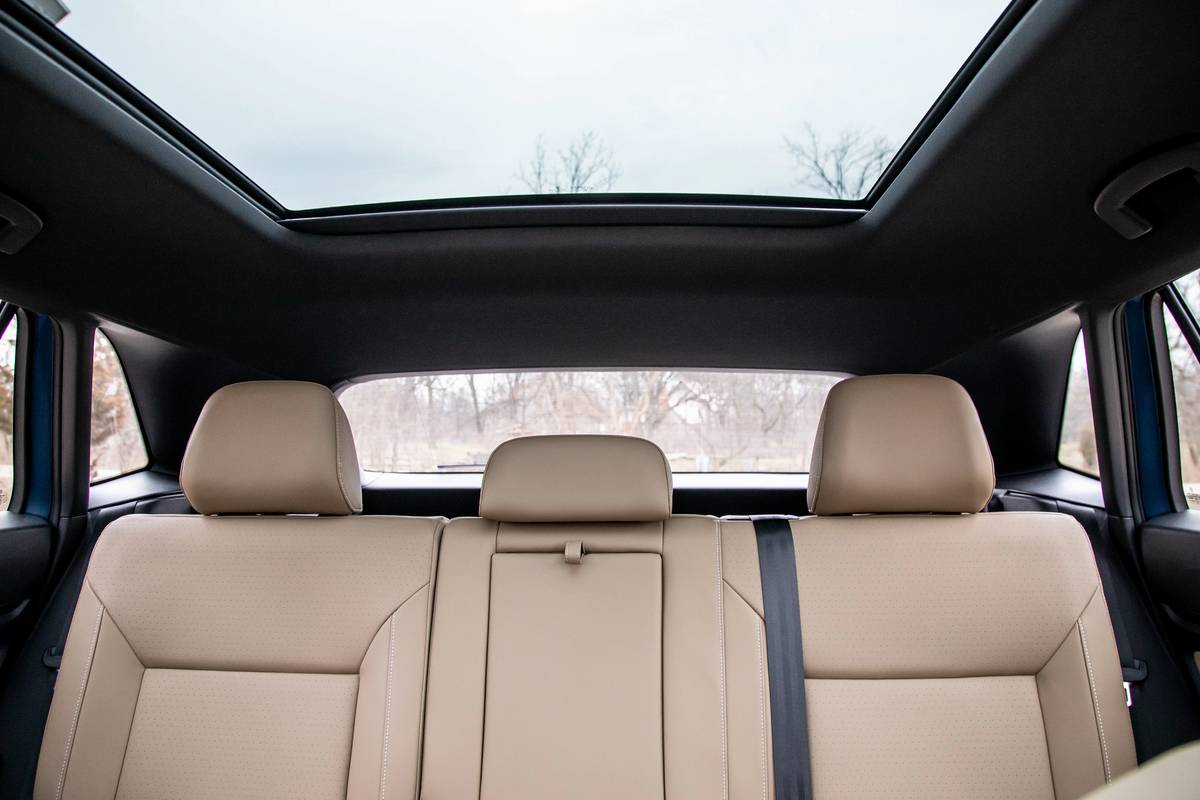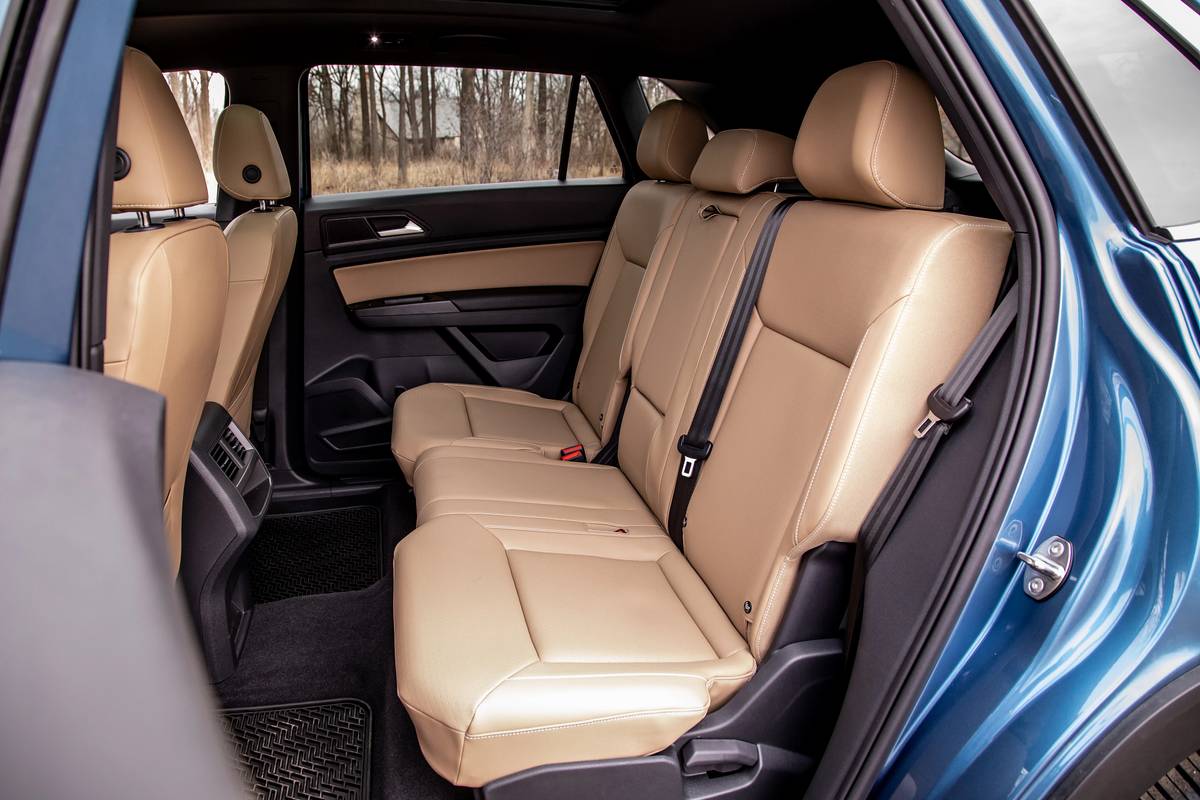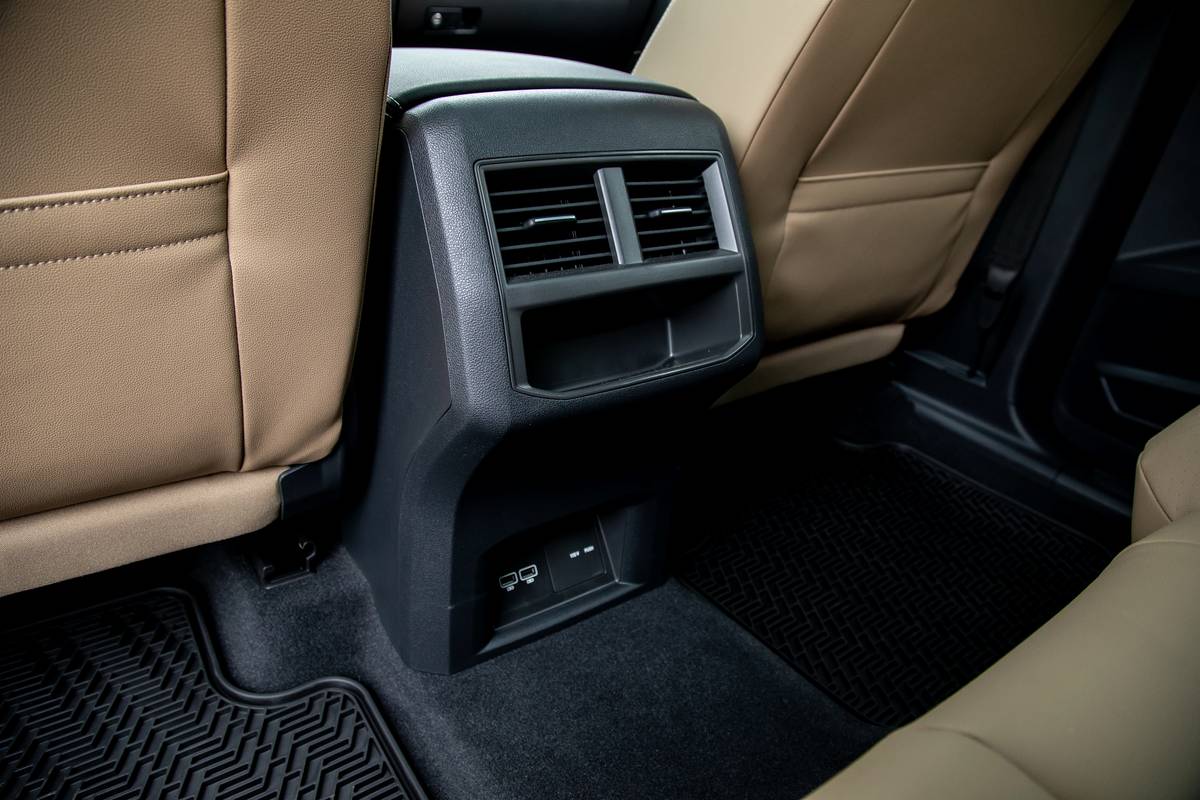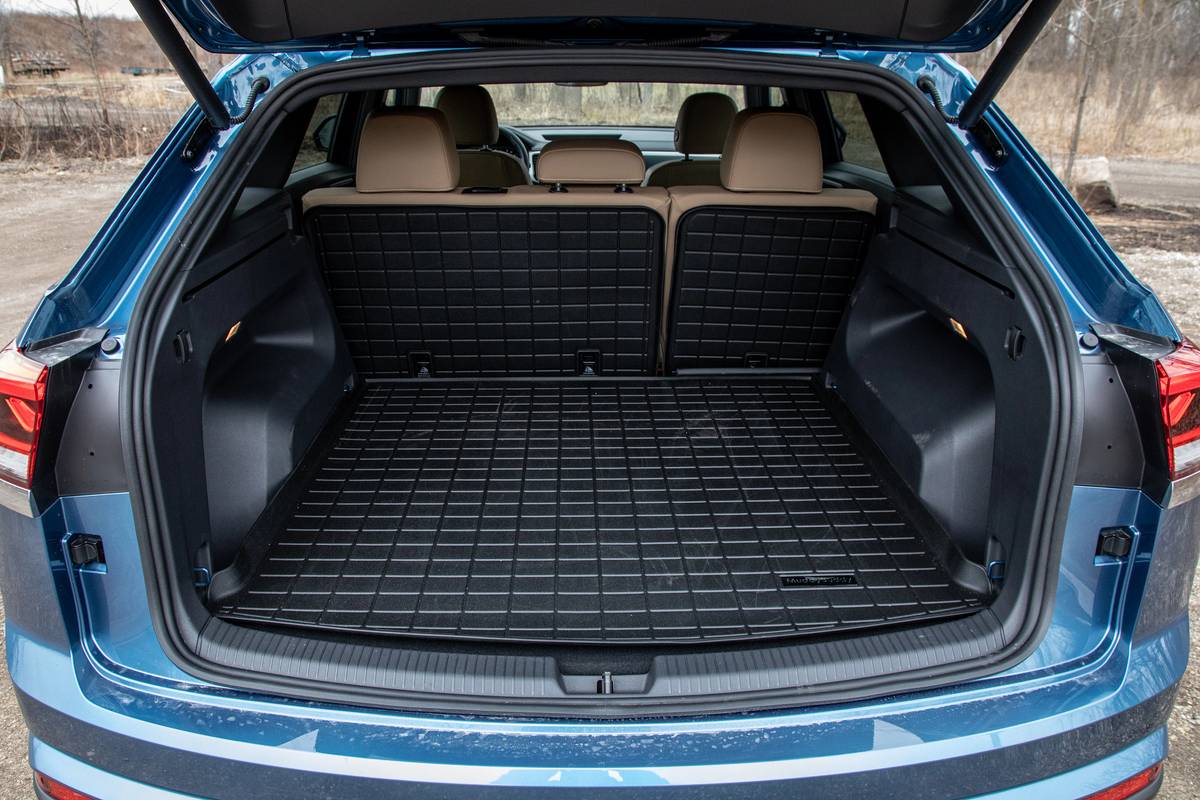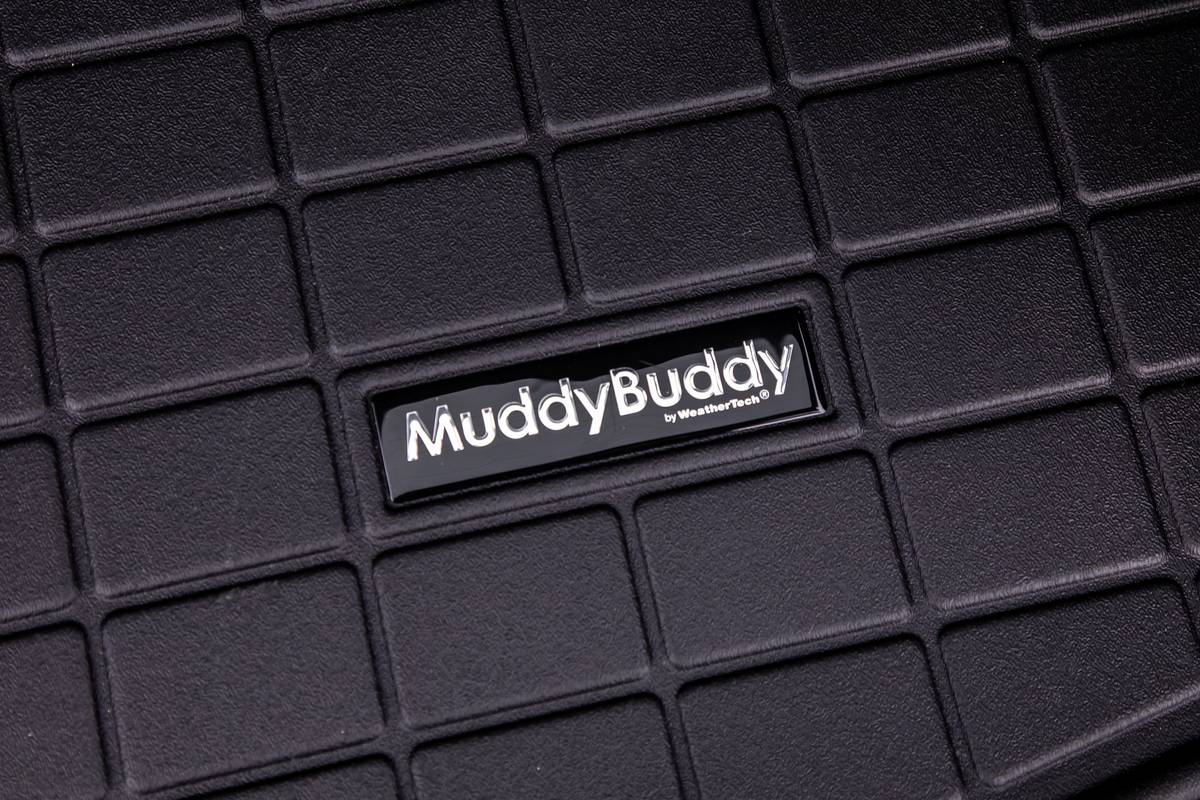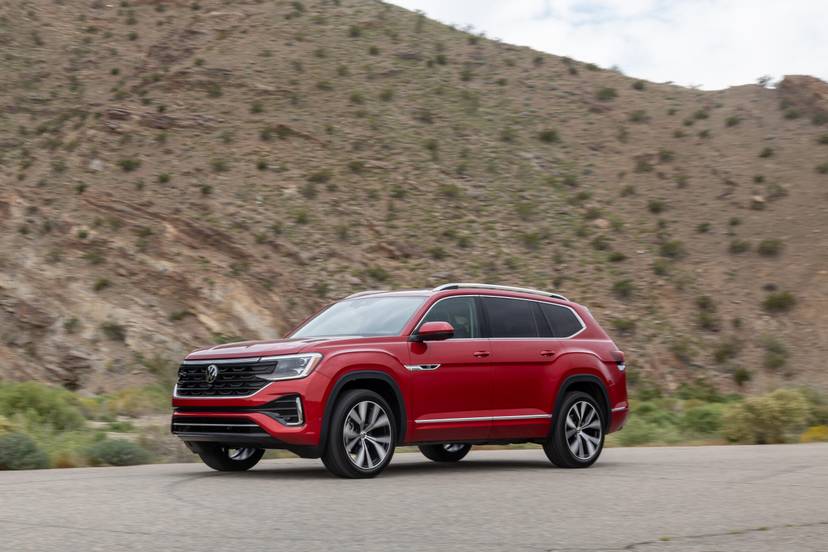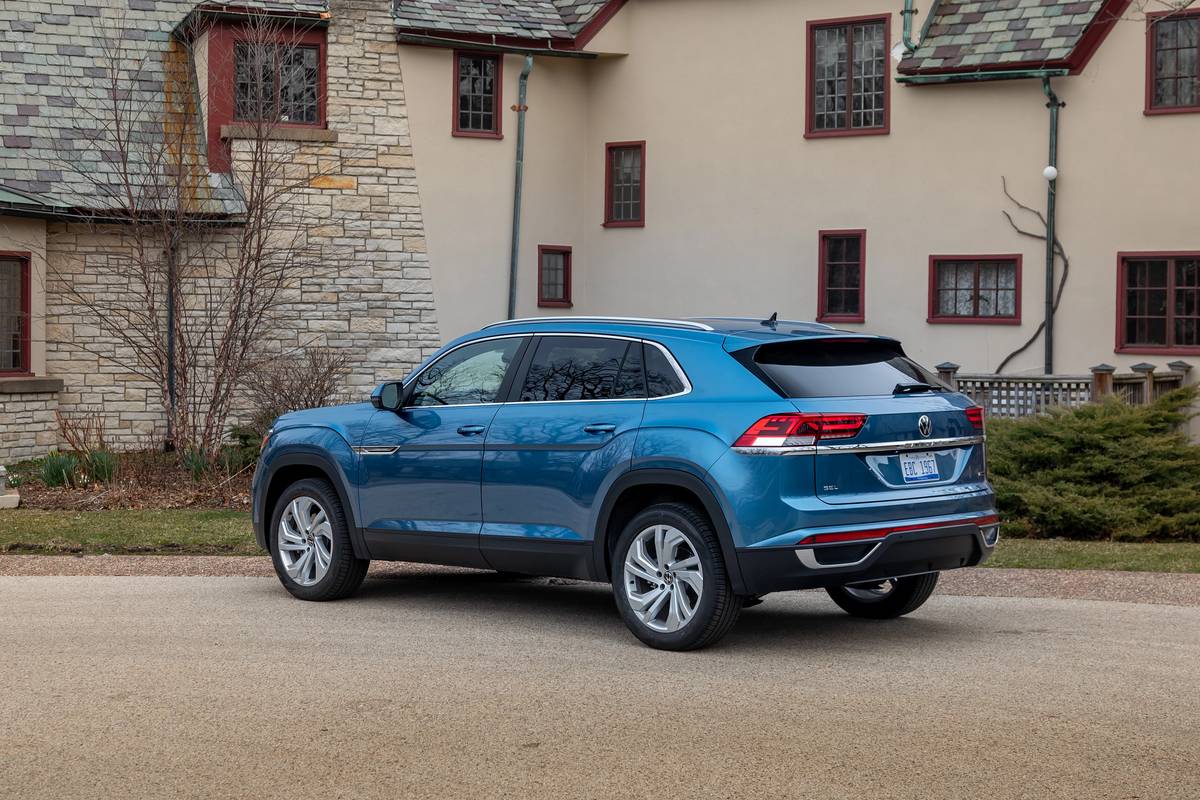
The verdict: The Volkswagen Atlas Cross Sport, like its bigger brother Atlas, carries people and cargo first — luxury comes at least third, maybe fourth.
Versus the competition: What the Atlas Cross Sport lacks in opulence it makes up for in sheer roominess and great drivability.
We’re fans of the Volkswagen Atlas and quite familiar with it — we’ve given VW’s big people mover a bunch of awards, including our most prestigious. But what if you need to haul fewer people? New for 2020 is the Volkswagen Atlas Cross Sport, which is a two-row, five-seat version of the three-row Atlas that competes less with the Ford Explorer and Hyundai Palisade and more with the Ford Edge and Hyundai Santa Fe.
Related: VW Unveils Coupified, Two-Row 2020 Atlas Cross Sport
What’s the Difference Between the VW Atlas and Atlas Cross Sport?
How the Atlas Cross Sport differs from the Atlas, besides seating fewer people, lies in its styling and exterior dimensions. The Atlas Cross Sport is a stylized version of the original Atlas that sort of looks like Audi’s Q8 from the rear. You can determine for yourself if the Atlas Cross Sport’s styling tickles your fancy — it will be a big consideration given it’s a substantial part of what’s changed. After all, image and lifestyle help drive the success of the biggest player in this class, the Jeep Grand Cherokee. (You might not want to trust my judgment, though; I currently have a 1977 Oldsmobile Cutlass saved in my Cars.com favorites list.)
The Atlas Cross Sport has a lower roof than the Atlas that slopes downward after the backseat to give it a more coupelike appearance. Dimensionally, the two-row Atlas is 5.2 inches shorter from bumper to bumper than the 2021 three-row version, and the Cross Sport’s roof is 2.6 inches lower. Mechanically, the cars are almost identical, with the same wheelbase, engine and suspension offerings, as well as the same interior design.
One anecdote that might be in VW’s favor: At the 2020 Chicago Auto Show, I overheard a group of 30-somethings gushing about the Atlas Cross Sport on the show floor. That version was painted the optional Pure Gray ($395), a nonmetallic flat gray that looks like the Nardo Gray common on $100,000 500- and 600-horsepower Audis. I wasn’t as wooed (but remember, I’m currently pining over a crusty Oldsmobile).
More Room in Some Ways, Less in Others
Because there’s no third row to encroach upon, VW shifted the second row’s position rearward to a fixed position instead of the sliding second row in the three-row Atlas. While on paper it looks like there’s 3 more inches of legroom, the Atlas and Atlas Cross Sport have similar maximum legroom because of where the Atlas’ second row is measured from, which isn’t the fully slid-back position. Imagine taking an already large, space-efficient vehicle, removing the third row and shoving the resulting car in the two-row class. Most other mid-sizers don’t have the backseat width and legroom that already makes the regular Atlas so competitive in a larger class of SUVs. Suffice to say, the resulting expansive Cross Sport backseat is hard to match in this class. The Honda Passport took a similar approach as a two-row version of the Honda Pilot and had similar success, but the Pilot is less competitive overall than the three-row Atlas.
There are 2.6 fewer inches of headroom in the Atlas Cross Sport because the roof is lower, but the Atlas had plenty of room to give. The backseat doesn’t slide as it does in the three-row Atlas — which would have opened the cargo area a little more — but it does recline and is supremely comfortable with the backrest angled rearward.
Less Cargo Space, But Still Plenty
There’s less cargo room than in the three-row Atlas: On paper, you’re giving up 15.2 cubic feet of volume behind the second row, which is a little less than the amount of space a 2020 Toyota Highlander has behind its third row. Here’s why that doesn’t matter: Even after slicing off all that room (because the roof dips and the car ends 5 inches sooner), the Atlas Cross Sport still has more cargo room than its competitors. By our method (not the OEM specs that can drastically vary in methodology), the Atlas Cross Sport has more cubic feet of space behind its backseat than an Edge, Grand Cherokee, Passport or Nissan Murano.
Athletic, But Not Sportier, Driving
Because its major changes are in styling and packaging, there’s not a whole lot different in how the Atlas Cross Sport drives, which is good and bad. It’s good because the Atlas is one of the most athletic-driving SUVs in its class, with quick steering reflexes and an eagerness to turn that defies its size. I drove a 2.0-liter four-cylinder with all-wheel drive, a new combination for 2020 that’s carried on in the updated 2021 Atlas. Prior to the 2021 model year, the Atlas four-cylinder was a limited offering available only with front-wheel drive.
What about the bad? It’s not necessarily bad, but for something with “Sport” in its name, the Atlas Cross Sport isn’t particularly unique — or any sportier to drive than the regular Atlas.
I had never driven a four-cylinder Atlas before this, and I didn’t even know I was driving the four-cylinder initially. That’s a testament to how good VW’s turbo four performs in everyday driving (at least in the flatlands of the Midwest). The engine is a turbocharged 2.0-liter like the ones in the Volkswagen Arteon and Jetta GLI, and it’s generally a top-notch experience — if you ignore the fine print about power and octane …
Should VW’s Turbocharged 2.0T Run on Regular or Premium Octane?
The fuel-filler door says 87-octane is the recommended fuel, so we assume it’s perfectly safe to use regular gasoline, but doing so with the 2.0-liter means you won’t be getting the advertised horsepower and torque. Maximum performance comes only on 91-octane or higher premium fuel, according to the Atlas Cross Sport’s owner’s manual, which states: “Arteon, Atlas 2.0 and Jetta GLI: Volkswagen recommends the use of premium fuel with an octane number of 91 to ensure that the specified output and torque are achieved.”
On the Atlas Cross Sport, running on premium provides 235 hp and 258 pounds-feet of torque, compared with the V-6’s 276 hp and 266 pounds-feet of torque on regular-octane gasoline. We asked VW how much power and torque you’d lose using regular octane, but it didn’t provide an answer before publication.
Four- or Six-Cylinder Atlas?
I question whether you need the six-cylinder. If you tow more than 2,000 pounds, then yes, you need the V-6; the 2.0-liter’s towing capacity is 2,000 pounds, while the six can pull 5,000 pounds (with an available hitch and a trailer that has brakes).
Otherwise, the four-cylinder’s off-the-line grunt and low-rpm torque make it perfectly adequate around town, even on regular octane — so much so that when I went from the six-cylinder to the four, I mainly just noticed that it sounded a bit growlier, which I now know is just the sound of the 2.0-liter. The four-cylinder is down 40 hp versus the six, but torque is only 10 pounds-feet less, and it propels a lighter vehicle than a comparable V-6 trim level (the SEL AWD), giving the 2.0-liter a good chance. The four-cylinder Atlas Cross Sport is 123 pounds lighter than the V-6 version and 214 pounds lighter than a three-row Atlas with the V-6 and all-wheel drive.
If you care to do so, the four-cylinder engine responds better to efficient driving than the V-6. My 2.0T SEL AWD test car was rated 18/23/20 mpg, but I squeaked out mileage in the high 20s driving efficiently in Eco mode at 55-65 mph. What we experienced over 12,000 miles in an Atlas SEL AWD six-cylinder was that you couldn’t coax much mpg out of it no matter how you drove; we averaged 18.6 mpg at the end of a year’s ownership.
The 2.0T has better mpg ratings than the V-6 (it’s up 3 mpg in combined ratings with FWD and 1 mpg with AWD) and is $1,800 less expensive. If you do put premium in the tank, however, you’ll spend more in fuel for the less expensive engine, meaning it will end up costing more over the course of five years than if you’d paid for the V-6 (based on current fuel prices).
Your deciding factor should really be which one you can get for a better price or is the color or trim level you want, not any merits of driving (unless you don’t care if you’re getting the car’s maximum performance and are OK putting regular fuel in the four-cylinder to save coin.) Now that the four-cylinder and all-wheel drive are pairable across all trim levels (S, SE, SE with Technology, SE R-Line, SEL R-Line and SEL Premium), there are more four-cylinders in Cars.com’s national inventory than V-6s.
Interior Quality and Technology
Another aspect of the Cross Sport that’s not different enough from the three-row Atlas is interior quality. Its interior was one of the main reasons the Atlas placed third in our three-row SUV comparison; if it were as killer as the Palisade’s with its optional suedelike interior trimmings, metal speaker covers and diamond-stitched leather, the Atlas’ size and other merits might have landed it on top of the heap. For something like the Atlas Cross Sport, which is focused more on style than utility, having the same basic interior as the regular Atlas feels like a mistake; I’d like to see a little more opulence. There’s newly available dark red leather upholstery on the top SEL Premium trim and additional contrast stitching that’s a nice touch, but neither are transformative.
Also newly available are Dynamic Road Sign Display and Traffic Jam Assist, which are becoming more common features to see on new and redesigned models. The dynamic road sign feature on SEL and SEL Premium trims uses a forward-facing camera to read road signs, such as speed limits, and display them in the digital instrument panel or center touchscreen. VW’s Traffic Jam Assist — also standard on SEL and SEL Premium trims — uses the car’s adaptive cruise control and lane centering to help steer, accelerate and brake at speeds up to 37 mph to reduce fatigue while driving in bumper-to-bumper traffic.
Who Should Buy an Atlas Cross Sport?
VW is targeting small families and empty-nesters who want something bigger than a Tiguan. Basically, if you don’t need a third row but want an expansive backseat, the Atlas Cross Sport should be right up your alley. The Atlas Cross Sport SEL I tested was $42,700 with destination — reasonable given how much room there is and how well the Atlas drives. That’s $950 less than a comparable 2021 three-row Atlas 2.0T SEL AWD, which has some of the same new features and front styling updates.
The Atlas Cross Sport has all the merits of a regular Atlas, as well as some of its downsides — like interior richness, which might not translate as well into the mid-size two-row class, where buyers aren’t as laser-focused on functionality. Even so, if you’re considering a Ford Edge, Honda Passport, Jeep Grand Cherokee or Nissan Murano, the Atlas Cross Sport should be on your list, too.
Cars.com’s Editorial department is your source for automotive news and reviews. In line with Cars.com’s long-standing ethics policy, editors and reviewers don’t accept gifts or free trips from automakers. The Editorial department is independent of Cars.com’s advertising, sales and sponsored content departments.








































